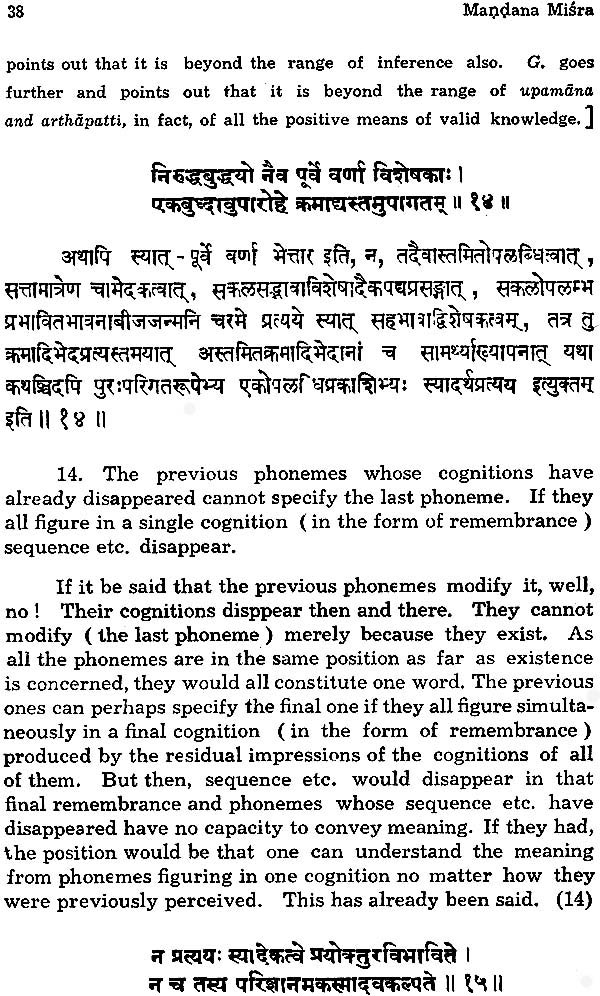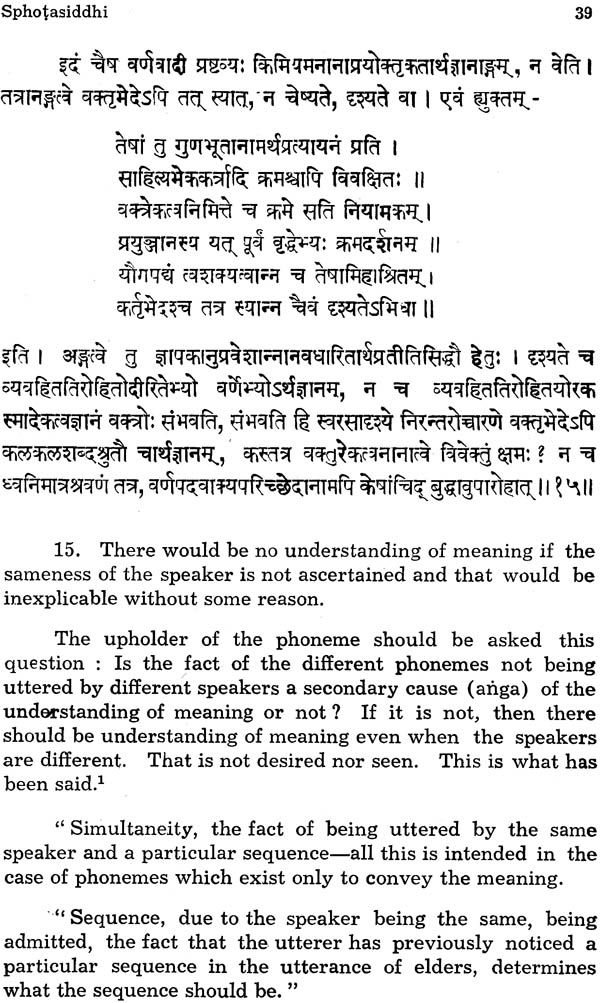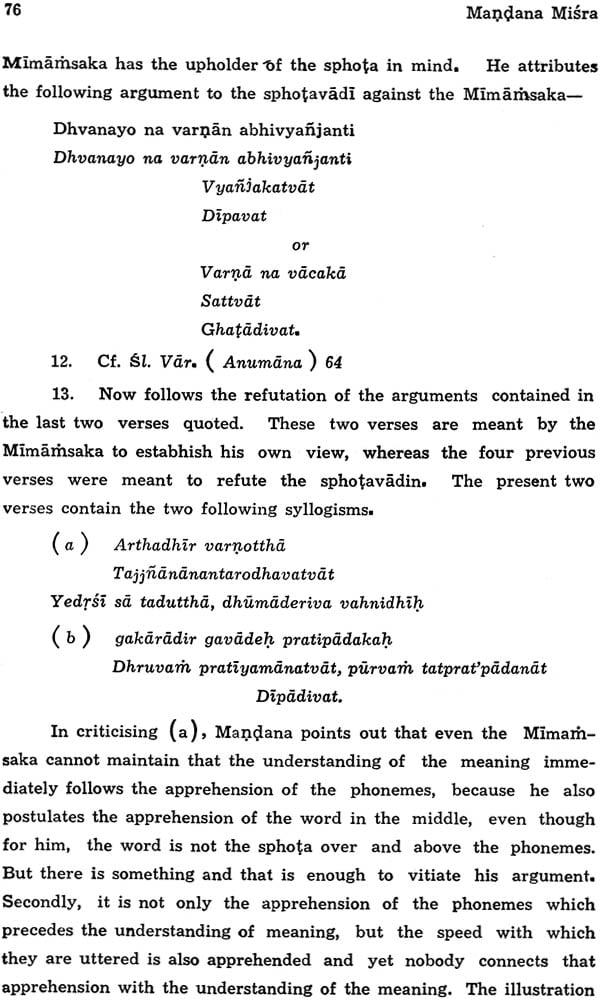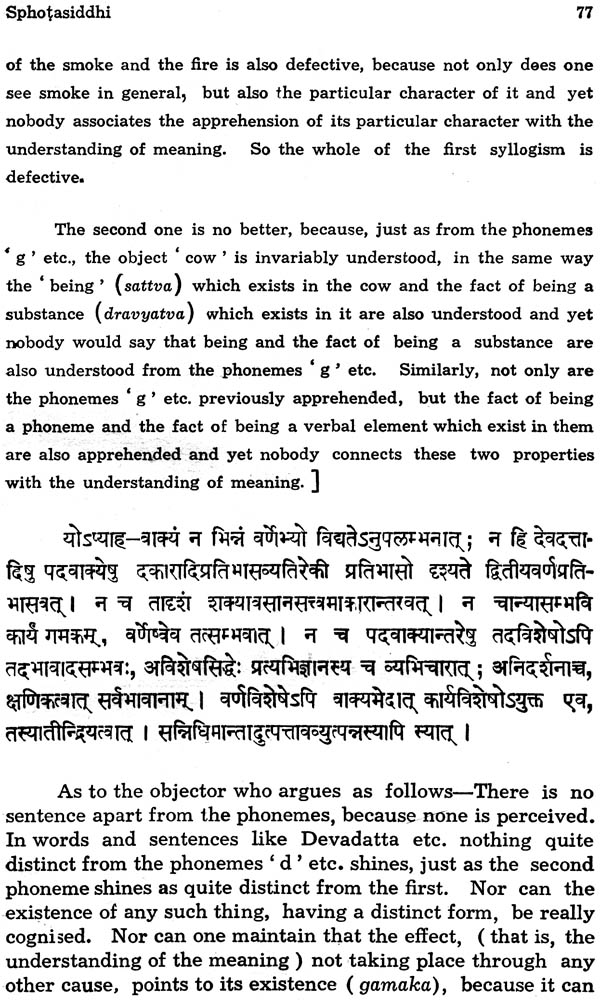
Sphotasiddhi of Mandana Misra - A Rare Book
Book Specification
| Item Code: | NAG962 |
| Author: | K.A. Subramania Iyer |
| Publisher: | Deccan College Postgraduate and Research Institute |
| Language: | Sanskrit Text with English Translation |
| Edition: | 1966 |
| Pages: | 100 |
| Cover: | Paperback |
| Other Details | 8.5 inch X 5.5 inch |
| Weight | 170 gm |
Book Description
I
No apology is needed for publishing a translation of a work of an author of the calibre of Mandana Misra in Indian philosophy. A draft of this translation had been lying with me for many years. I made it chiefly as an aid to my study of the work. On the basis of my study, I published an article entitled "The Doctrine of Sphota" in the Journal of the Ganganatha Jha Research Institute, Vol. V pp. 120-147. But I always had an idea of publishing the translation some day. When Dr. S. M. Katre suggested that he would like to include it in the Deccan College Building Centenary and Silver Jubilee Monographs, I agreed to revise it and get it ready for publication. In the meantime. Dr. M. Biardeau's French translation of it with a revision of the text by Sarvashri N. R. Bhatt and T. Ramanujam had appeared in 1958 as N 0. 13 of the "Publications de 1' Institut Francais d' Indologie, Pondicherry" After reading it, I did not think that any change was called for in my earlier translation of the Work. Though, in the revised text of the work published with the French translation, some variant readings, mainly from the commentary Gopalika, are given in the footnotes, the translation itself is based on the text of the Madras University Sanskrit Series, No 6 (1931). My translation is also based on that text which is, therefore, given here for the convenience of the reader. The author of the Gopalika knew many variant readings of the text at many places, but he shows his preference for one of them and the editor has usually adopted it. Paramesvara, the author of the Gopalika, may have had manuscipit authority for the variant readings which he mentions but does not seem to favour. I suppose he had manuscript authority also for the readings which he seems to have adopted.
A few notes have been added to my translation of all but three of the karika-s and Mandana's Vrtti on them. They are partly explanatory and partly in the nature of references to the works on which Mandana's observations are based. The Gopalika is a word for word explanation of the karika-s and the Vrtti on them. Paramesvara has spared no pains to make the meaning of Mandana Misra clear He has not aimed at brevity in his explanations. In fact, some may find his oommentary too elaborate. In some places, he gives alternative explanations which also appear to be acceptable. Many of my notes are based on the Gopalika, in some places, I have actually quoted it.
II
Tradition associates Mandana Misra with Sankaracarya, of whom he may have been an elder contemporary. The following works of his are known:
1. Brahmasiddhi
2. Vidhiviveka
3. Bhavanaviveka
4. Vibhramaviveka
5. Mimamsanukramani
6. Sphotasiddhi
In the Sphotasiddhi with which we are concerned Mandana Misra establishes the existence of Sphota. The Sphota doctrine is that of the Grammarians and the chief exponent of it is Bhartrhai (5th cent. A. D.?). The chief opponents of the Sphota doctrine were the Mimamsakas and their chief representative in this matter was Kumarila Bhatta (VIth cent. A D.?) who, in his Slokavarttika (sphotavada) has put forward his arguments against the acceptance of sphota. Mandana Misra came after both and quotes the Vakvapadiya and the Slokavarttika in his Sphotasiddhi, It would be correct to say that Mandana Misra states, in his own words, the main arguments of Kumarila against the sphota doctrine, supported by quotations from the Slokavarttika wherever necessary. Similarly, in order to establish the existence of sphota, he presents the arguments of Bhartrhari, again in his own words, with, of course, quotations from the Vakyapadiya wherever necessaay. The essence of the sphota doctrine is the idea that the word, mainly in the form of the sentence and secondarily in the form of the individual word and the phoneme, is an entity over and above the sounds and not a mere collection of them and that it is this entity which is the bearer of the meaning. It is an indivisible entity which already exists in everybody.
The speaker manifests it when he utters the sounds by the movements of the vocal organs. When the hearer hears these sounds, this indivisible entity which is in him also is awakened and he understands the meaning which the speaker wants to convey and which is eternally associated with the word which has been awakened. This entity over and above the sounds is. the sphota, primarily the sentence sphota, but secondarily also the word sphota and the phoneme sphota. As against this, the Mimamsaka holds that there is no entity over and above the phonemes. The word, whether it be the sentence or the individual word, is nothing more than a collection or group of phonemes and it is with this collection that meaning is associated. When the group is brought to the the mind of the hearer by the sounds uttered by the speaker, he understands the meaning.
For the grammarian, this entity over and above the sounds, eternally associated with meaning, has its roots deep in the Self, not only of this life, but of the previous lives also. It is the very essence of the Self. It is part of the personality which we have inherited from our previous lives. Mandana Misra does not go into this aspect of sphota in his Sphotasiddhi, I shall, therefore, not deal with that aspect of sphota in this introduction, especially as I am dealing with that topic in my study of the Vakyapadiya which will be published in due Course. In the Sphotasiddhi, Mandana deals mainly with the question whether the word which conveys the meaning is an entity over and above the sounds or the phonemes. His answer is that it is an-i it is because he has tried to establish its existence apart from the sounds that the work is called the establishment of sphota, the Sphotasiddhi, For Bhartrhari the sphota has mainly the form of a sentence, but he accepted the word-sphota and the phonerne-sphota also. What Mandana's attitude was on this point will be discussed later. Suffice it to say for the present that in the Sphotasidhi, Mandana tries to establish the padasphota as against the Mimamsaka for whom the word was nothing more than the phonemes themselves.









